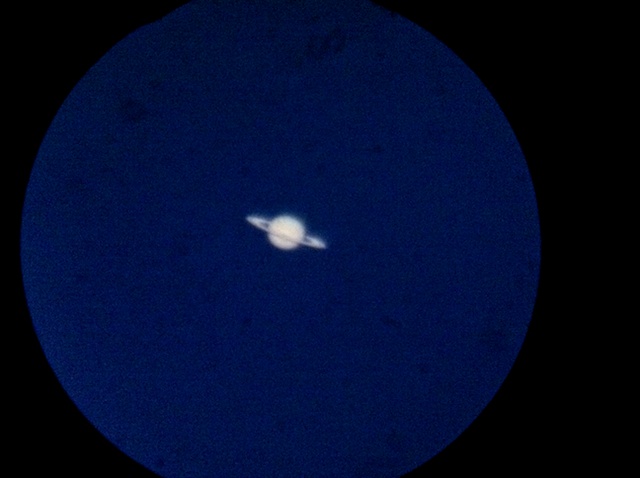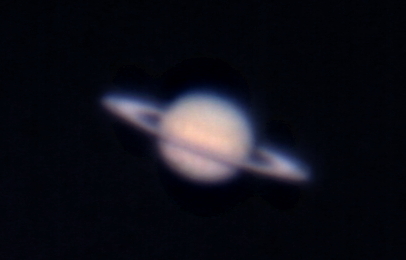
Saturn, ISS
Last updated: 16 June 2011![[Home!]](http://www.weasner.com/etx/images/mighty_etx_logo_orig-sm.jpg)
 |
Saturn, ISSLast updated: 16 June 2011 |
![[Home!]](http://www.weasner.com/etx/images/mighty_etx_logo_orig-sm.jpg) |
| Follow @mweasner | Welcome | Photos | Videos | Equipment | Links | Data |
Wednesday, 15 June, dawned clear and calm, but some clouds began showing up mid-day. And the winds kicked up again mid-afternoon. Opened the observatory at 1759 MST, 108°F, to clear skies, but I delayed opened the dome due to the strong breezes that were still blowing. I did some tests with a pre-release of SkySafari 3+ v3.0.2 and the SkyWire to see if the developer had fixed a bug I had reported. They did. The new version should be available soon.
The dome was opened at 1835 MST and I viewed Saturn in the 26mm eyepiece (77X). I then updated the TLE in the AutoStar II for the night's ISS pass. Then back to Saturn; viewed it in the 15mm eyepiece (133X), and at 1909 MST, with the 9.7mm (206X) eyepiece. It was a nice view at 206X, but no moons were currently visible (bright sky). I then set up for iPhone afocal imaging with the 8" LX200-ACF. A few minutes after sunset, I took this image, 9mm eyepiece + 3X TeleXtender (666X):

I did a video recording of Saturn with the iPhone 4. You can see the short video (6 seconds) here. I stacked the video using Keith's Imager Stacker (147 frames), yielding this (cropped) image:

At 1944 MST, about 25 minutes before the pass was to begin, I set up for imaging the ISS. Mounted the D7000 DSLR at prime focus + 3X TeleXtender. Focused on Saturn, locked the focus, and did a test video recording. I then began waiting for the pass to start. The ISS was several minutes late and so the tracking was way off. There had been another orbit boost scheduled for this day and I guess it happened, invalidating the TLE I had downloaded earlier in the day. About mid-pass I caught up with the station and had one frame with a reasonable image. This cropped view shows a blurry station:

I have determined that I need to use a faster shutter speed on the D7000 DSLR when video recording the ISS. However, I am not certain that can be changed; I will have to check the camera manual. Unfortunately, there are no good ISS passes for at least the next 8 days.
Closed the observatory at 2040 MST, 81°F. During the night, I terminated three Kissing Bugs that had come inside the observatory.
Some Notes on Tracking the ISS
Some readers have wondered how I track the International Space Station (ISS). The ISS moves rapidly across the sky, making it difficult to track it by manually slewing or moving a telescope by hand, even with low magnification. Some modern GOTO telescopes have software that will track satellites. There are also computer programs that will send slewing commands to your telescope to track satellites. Meade telescopes with the AutoStar can track satellites. You can download Two Line Elements (TLE) to the AutoStar using the AutoStar Update Application (Windows only) or manually enter the TLE data (from Heavens-Above.com) into the AutoStar. Since I don't use Windows, I manually enter the data for the ISS. The article "Tracking the International Space Station" on my ETX Site has instructions on how to manually enter the TLE data. Once you have the current TLE added, the AutoStar will track the ISS. However, tracking is not perfect and you will have to make manual corrections with the AutoStar slew arrow keys to keep the ISS in an eyepiece (or camera) field-of-view (FOV). When the ISS (or any satellite) is near the horizon, the satellite moves slowly across the sky; tracking corrections are usually minimal and may not even be needed. However, as the satellite gets closer to you, getting higher in the sky, it moves ever faster and faster, and manual corrections become more frequent. As the satellite goes away from you in its orbit, its movement across the sky seems to slow down and tracking corrections become less. When the satellite is furthest away from you, especially when close to the horizon, it is at its smallest and atmospheric distortion will obscure details. When the satellite is at its closest to you and hence at its largest, it is also moving the fastest, requiring the most corrections. An Alt/Az mount is best for satellite tracking. A polar mounted telescope can be used but at some orientations of the telescope, depending on the orbital parameters, it can be difficult to look through the finderscope and/or eyepiece. And since the telescope is rapidly slewing at times, you don't want to stumble over your tripod as you move to follow the satellite. These factors make viewing and imaging details challenging.
When I first began tracking the ISS, I visually observed it with a 26mm (77X) eyepiece. That gave me a nice wide FOV with some reasonable magnification, allowing the ISS solar panels and central core to be seen. As the satellite moves in its orbit, it can change from a very bright silver to an orange or gold color on the solar panels. And as the perspective changes during the pass, you will get differing views of the station. Once I was comfortable with tracking the ISS at 77X, I began using a 15mm (133X) eyepiece. This was more challenging with the higher magnification and smaller FOV. But the views were more rewarding with the increased magnification.
Eventually, I began imaging attempts, first with an iPhone and later with a D7000 DSLR. The iPhone was mounted afocally with a 26mm eyepiece and a video recording made during the pass. I could then look at each frame of the recording on the computer, finding the best images to show. I also did afocal imaging with a 15mm eyepiece. I was never fully satisfied with these images, although some were pretty good and showed the overall structure of the ISS with the solar panels. I switched to using the D7000 DSLR at prime focus and later at prime focus + 2X Barlow Lens (or 3X TeleXtender). I used the HD video recording mode on the DSLR. With both the iPhone and DSLR, motion blur from the rapid slewing is the biggest problem, although keeping the ISS in the camera FOV is always a challenge. You can see some of my ISS images on my "Satellite Astrophotography" page.
Whether viewing the ISS with your eye or a camera, sometimes it will go out of the FOV. Then you will have to move to viewing through your finderscope and re-center the ISS. You then go back to the eyepiece and camera and hope that the ISS has not moved so rapidly as to be out of the FOV again. This game of "cat and mouse" is frustrating at times but the effort will be worth the views or images. Give it a try.
For another take on tracking the ISS, see this excellent YouTube video (thanks Ray for the referral). The video discusses getting the ISS pass times, how to manually track the ISS, video recording using a webcam, and editing the video.
Go to the previous report.
Return to the Cassiopeia Observatory Welcome Page.